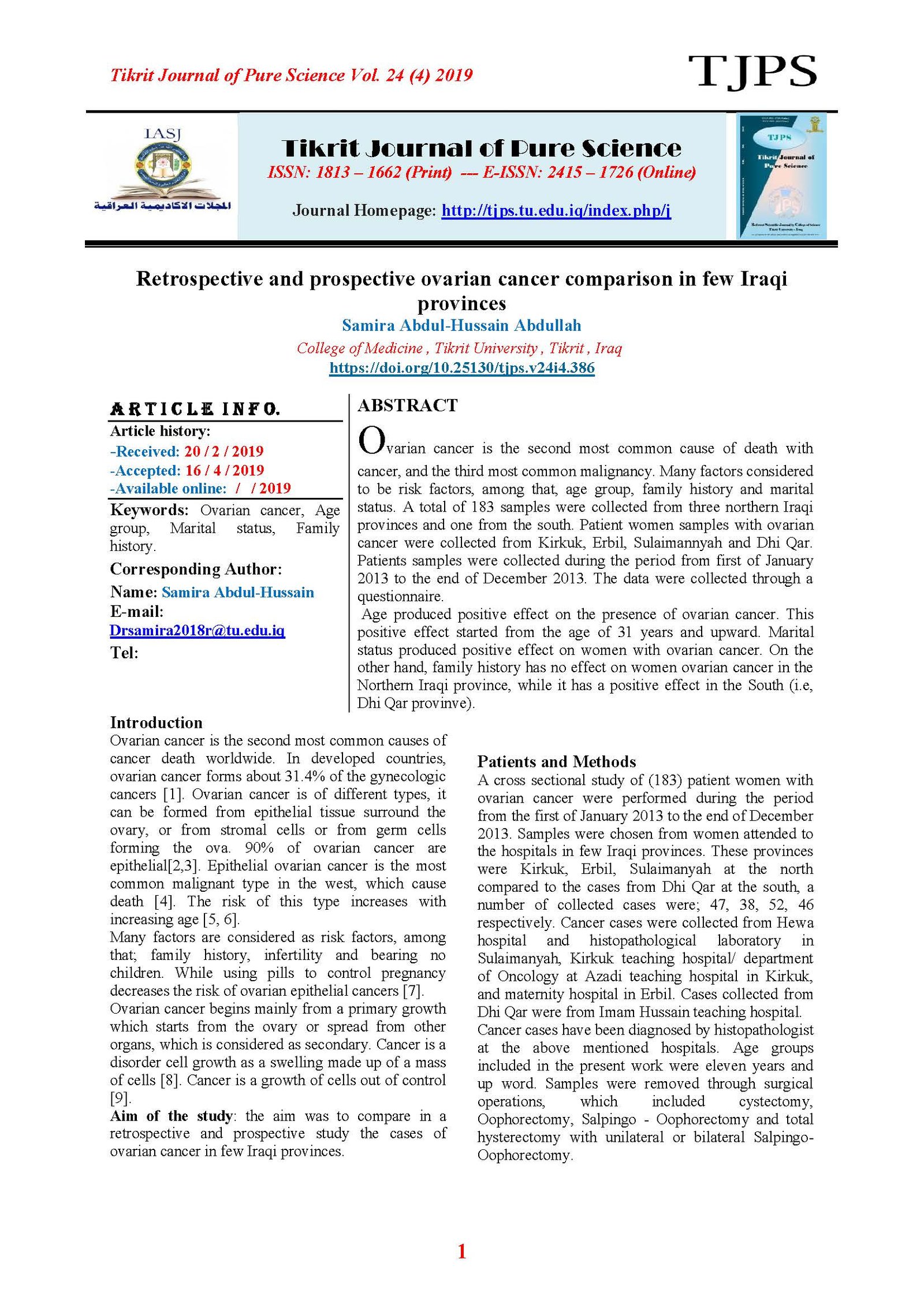Retrospective and prospective ovarian cancer comparison in few Iraqi provinces
Main Article Content
Abstract
Ovarian cancer is the second most common cause of death with cancer, and the third most common malignancy. Many factors considered to be risk factors, among that, age group, family history and marital status. A total of 183 samples were collected from three northern Iraqi provinces and one from the south. Patient women samples with ovarian cancer were collected from Kirkuk, Erbil, Sulaimannyah and Dhi Qar. Patients samples were collected during the period from first of January 2013 to the end of December 2013. The data were collected through a questionnaire.
Article Details

This work is licensed under a Creative Commons Attribution 4.0 International License.
Tikrit Journal of Pure Science is licensed under the Creative Commons Attribution 4.0 International License, which allows users to copy, create extracts, abstracts, and new works from the article, alter and revise the article, and make commercial use of the article (including reuse and/or resale of the article by commercial entities), provided the user gives appropriate credit (with a link to the formal publication through the relevant DOI), provides a link to the license, indicates if changes were made, and the licensor is not represented as endorsing the use made of the work. The authors hold the copyright for their published work on the Tikrit J. Pure Sci. website, while Tikrit J. Pure Sci. is responsible for appreciate citation of their work, which is released under CC-BY-4.0, enabling the unrestricted use, distribution, and reproduction of an article in any medium, provided that the original work is properly cited.
References
[1] Jemal, A; Bray, F; Center, MM; Ward, E; and Forman, D. (2011). Global cancer statistics. CA cancer J clin.; 61:69-90.
[2] Kufe, D; Pollock, TE; Weichselbaum, RR; and Bast, RC. (2003). Holland Frei Cancer Medicine. 6th edi. Hamilton, Ontario: BC Decker..
[3] Antonion, AC; Casadei, S. Heikkinen, T. (2014). Cancer risk in families with mutations in PALB2. New Engl. J. Med.; 371 (6): 497-506.
[4] Stebbing, JI and Gaya, A (2002). Pegylated liposomal doxorubicin (Caelyx) in recurrent ovarian cancer. Cancer Treat Rev.; 28(2): 121-5.
[5] Tang, L; Zheng, M; Ying xiong, Y; Ding, H and Liu, Fu-Y. (2008). Clinical characteristics and prognosis of epithelial ovarian cancer in young women. CJC.; 27 (9): 238-41.
[6] Demirci, E; Daloglu, T; Calik, M; Altun, E; Sipa, S and Borekci, B. (2015). Changing trends in the incidence of ovarian neoplasia and its relationship with the risk factors: A report of 311 cases from North –Eastern Anatolia region..
[7] Berek, JS; and Haker, NF. (2003). Epithelial ovarian cancer. Pract. Gynecol. Onco.; 4: 443-94.
[8] Mcmanus, LM; and Mitchell, RN. (2014). Pathobiology of human diseases: a dynamic Encyclopedia of disease. 1st ed. Elsevier. Inc.: 349-53.
[9] Maker, MP. (2000). Hormone therapy in epithelial ovarian cancer. Endocrine-related cancer.; 7: 85 -93.
[10] Abdul Majeed, AM and Yahy, TT. (2008). Pathological study of ovarian tumors in Mosul. Tik. Med. J.; 14(1): 157-160.
[11] Malik, JA. (2002). A prospective study of clinicopathological features of epithelial ovarian cancer in Pakistan. J Pak Med Assoc.; 52(4): 155-58.
[12] Merritt, MA; De Pari, M; Vitonis, AF; Titus, LJ; Grame, DW; and Terry, KL. (2013). Reproductive characteristics in relation to ovarian cancer risk by histologicpath ways. Human reproduction.; 28(5): 1406-17.
[13] Hegazi, RA; Abdel Wahab, K; EL-Nahas, W; Mosbah, M; Refky, B, and Mohamed, AH. (2013). Epidemiological and pathological correlates of postoperative mortality of patients with ovarian cancer. Surgery curr Res.; 3(1): 2-5.
[14] Kurian, AW; Baliseb, RR; Valerie-McGuireb, V; and Whittemore, AS. (2005). Histologic types of epithelial ovarian cancer: have they different risk factors. Gynecol oncol.; 96: 520-30.
[15] Samra, ZQ; Hussain, T; Khaliq, Z; UL-Haq, I, and Anwar, R. (2014). ovarian cancer among women of Lahore Metropolitan; a survey. IJIMS.; 1(6): 276-78.
